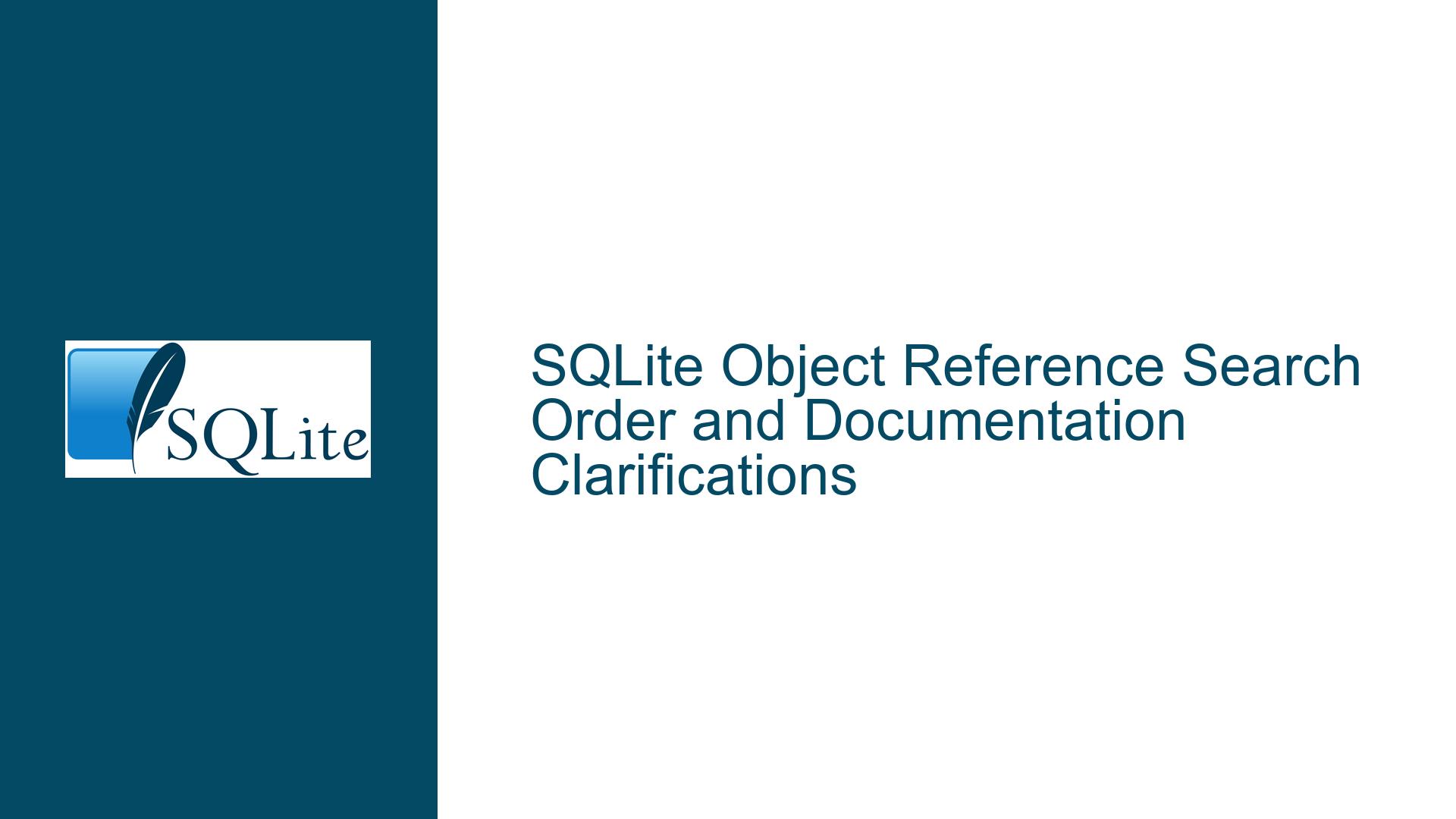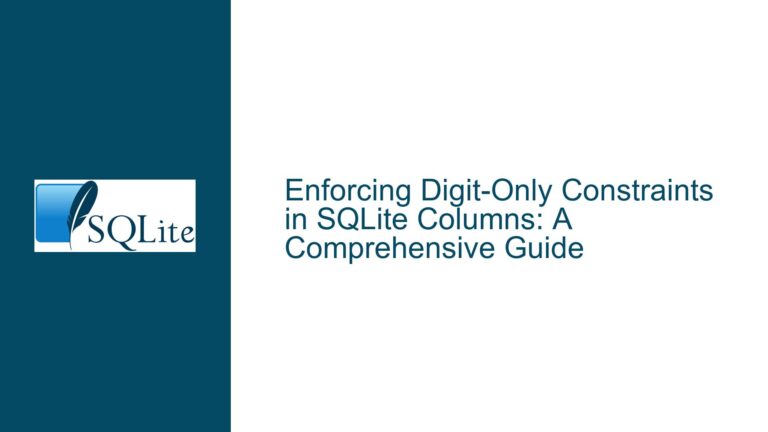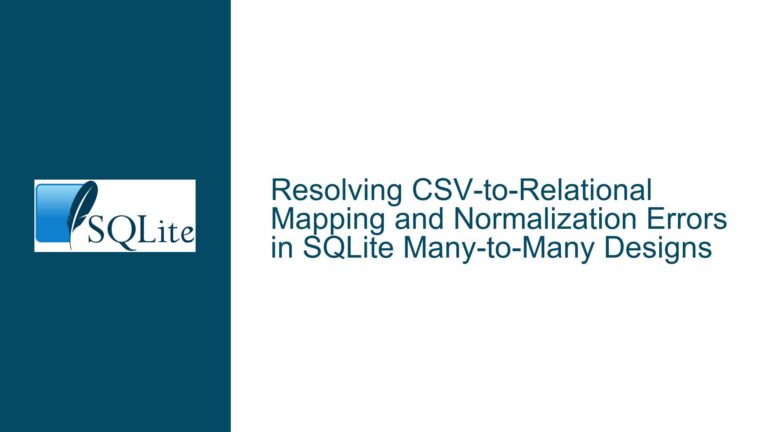SQLite Object Reference Search Order and Documentation Clarifications
Issue Overview: SQLite Object Reference Search Order and Documentation Ambiguities
The core issue revolves around the documentation on SQLite’s object reference search order, specifically how SQLite handles unqualified object references (tables, views, triggers, etc.) across multiple databases. The current documentation on the SQLite Naming Documentation Page states that if no database is specified in an object reference, SQLite searches the main, temp, and all attached databases for an object with a matching name. However, there is ambiguity in the documentation regarding the exact order of this search.
The discussion highlights two key points of confusion:
- The order in which SQLite searches databases when an object reference is unqualified. The documentation initially implies that the main database is searched first, followed by the temp database and then attached databases. However, empirical testing and further clarification suggest that the temp database is searched first, followed by the main database, and then attached databases in the order they were attached.
- The behavior of object references in the context of triggers and views. Specifically, whether these objects can reference tables or other objects across databases, and how the search order applies in these cases.
These ambiguities can lead to confusion for developers, especially when working with multiple attached databases or when defining triggers and views that reference objects across databases. Misunderstanding the search order can result in unexpected behavior, such as referencing the wrong table or object, which can be particularly problematic in complex database schemas.
Possible Causes: Documentation Inconsistencies and Edge Cases in Object References
The root cause of the issue lies in the documentation’s lack of clarity regarding the search order of databases when an object reference is unqualified. The documentation initially states that SQLite searches the main, temp, and attached databases, but it does not explicitly state the order of this search. This ambiguity is further compounded by the fact that the search order can have significant implications for database behavior, especially in scenarios involving multiple databases with objects of the same name.
Additionally, the discussion reveals edge cases in how SQLite handles object references within triggers and views. For example:
- Triggers: When a trigger is defined in the temp database, the table referenced in the ON clause may be qualified, and the search order applies to this clause. However, triggers defined in other databases can only reference objects within the same database.
- Views: Views defined in the temp database are treated as directly executed statements, meaning the search order applies. However, views defined in other databases can only reference objects within the same database.
These edge cases are not clearly documented, leading to potential misunderstandings and errors in schema design and query execution. The lack of clarity can also make it difficult for developers to predict the behavior of their SQLite databases, particularly in complex scenarios involving multiple databases and cross-database references.
Troubleshooting Steps, Solutions & Fixes: Clarifying Documentation and Best Practices
To address the issues raised in the discussion, the following steps and solutions are recommended:
1. Clarify the Search Order in the Documentation
The documentation should be updated to explicitly state the order in which SQLite searches databases when an object reference is unqualified. Based on empirical testing and the discussion, the correct order is:
- temp database
- main database
- Attached databases (in the order they were attached)
The updated documentation should read:
If no database is specified as part of the object reference, then SQLite searches the **temp**, **main**, and all attached databases (in the order they were attached) for an object with a matching name.
This change eliminates ambiguity and ensures that developers have a clear understanding of how SQLite handles unqualified object references.
2. Document Edge Cases for Triggers and Views
The documentation should include a dedicated section explaining how SQLite handles object references within triggers and views. This section should cover:
- Triggers: Triggers can only reference objects within the same database, except for triggers defined in the temp database. For triggers in the temp database, the table referenced in the ON clause may be qualified, and the search order applies to this clause.
- Views: Views can only reference objects within the same database, except for views defined in the temp database. Views in the temp database are treated as directly executed statements, and the search order applies.
This addition will help developers understand the limitations and behavior of triggers and views, particularly when working with multiple databases.
3. Provide Examples and Best Practices
To further clarify the behavior of object references in SQLite, the documentation should include examples and best practices. These examples should demonstrate:
- How to properly qualify object references to avoid ambiguity.
- How to handle scenarios involving multiple databases with objects of the same name.
- Best practices for defining triggers and views in multi-database environments.
For example:
-- Example 1: Qualifying object references
SELECT * FROM main.table_name; -- Explicitly reference the main database
SELECT * FROM temp.table_name; -- Explicitly reference the temp database
SELECT * FROM attached_db.table_name; -- Explicitly reference an attached database
-- Example 2: Defining a trigger in the temp database
CREATE TRIGGER temp.trigger_name
AFTER INSERT ON temp.table_name
BEGIN
INSERT INTO main.log_table VALUES (NEW.column_name);
END;
-- Example 3: Defining a view in the temp database
CREATE VIEW temp.view_name AS
SELECT * FROM main.table_name;
These examples will help developers apply the concepts discussed in the documentation to real-world scenarios.
4. Encourage Explicit Database Qualification
To avoid potential issues with unqualified object references, the documentation should encourage developers to explicitly qualify object references whenever possible. This practice reduces the risk of referencing the wrong object and makes the code more readable and maintainable.
For example:
-- Instead of:
SELECT * FROM table_name;
-- Use:
SELECT * FROM main.table_name;
By following this best practice, developers can ensure that their SQLite databases behave as expected, even in complex multi-database environments.
5. Update the Documentation to Reflect Current Behavior
Finally, the SQLite documentation should be updated to reflect the current behavior of the database engine. This includes:
- Correcting any inconsistencies in the search order description.
- Adding sections on edge cases and best practices.
- Providing clear examples and guidance for developers.
By addressing these issues, the SQLite documentation will become a more reliable resource for developers, helping them avoid common pitfalls and build more robust database applications.
Conclusion
The issues raised in the discussion highlight the importance of clear and accurate documentation, particularly when it comes to complex behaviors like object reference search order in SQLite. By clarifying the search order, documenting edge cases, and providing examples and best practices, the SQLite documentation can better serve developers and help them avoid common pitfalls. These changes will ensure that developers have a clear understanding of how SQLite handles object references, leading to more predictable and reliable database behavior.






